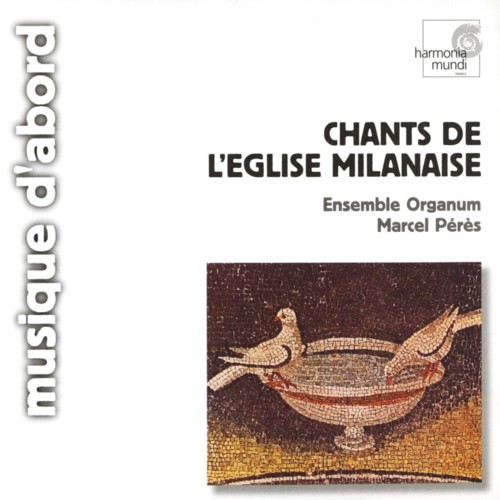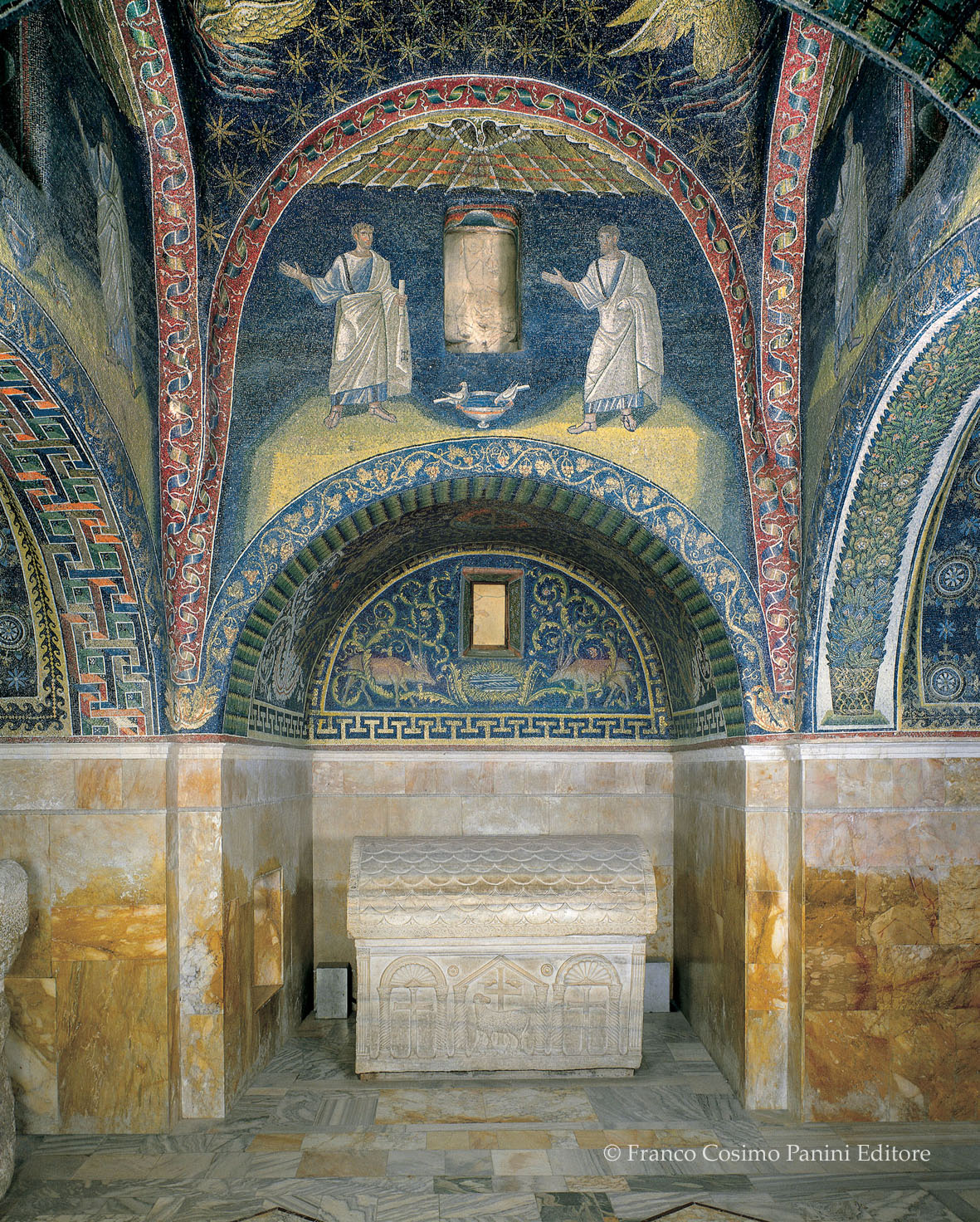Chants de l'Église Milanaise
Ensemble Organum

medieval.org
harmonia mundi HMC 90 1295 · 1989
harmonia mundi "Suite" HMT 790 1295 · 1999
harmonia mundi "Musique d'abord" HMA 195 1295 · 2003
1. Lucernarium. “Paravi lucernam Christo meo” [4:46]
tutti homes, soliste: Josep Benet
2. Psalmellus. “Tui sunt celi et terra” [5:32]
tutti, soliste: Josep Benet
3. Ingressa. “Lux fulgebit hodie super nos” [1:55]
soliste: Josep Cabré
4. Angelorum laus. “Gloria in excelsis Deo” [7:10]
solistes: Josep Benet, Malcolm Bothwell, Josep Cabré
5. Psalmellus. “Tecum principium in die virtutis tue” [10:27]
tutti femmes, soliste: Sœur Marie Keyrouz
6. Alleluia. V. “Hodie in Bethlehem puer natus est” [7:26]
tutti, Josep Cabré, Malcolm Bothwell
7. Offertorium. “Ecce apertum est”. “Templum tabernaculi” [11:33]
soliste: Lycourgos Angelopoulos
8. Canticum. “Ecce quam bonum et jocumdum” [5:52]
soliste: Josep Benet, Josep Cabré
9. Offertorium. “Hec dicit Dominus” [8:00]
tutti femmes, soliste: Sœeur Marie Keyrouz
10. Responsorium. “Congratulamini mihi omnes qui diligitis Dominum” [8:02]
tutti, solistes: Josep Cabré, Sœur Marie Keyrouz

Ensemble Organum
Marcel Pérès
Lycourgos Angelopoulos, Josep Benet,
Malcolm Bothwell, Josep Cabré, Antoine Sicot
Laurence Brisset, Sœur Marie Keyrouz, Marie-France Leclercq,
Florence Limon, Pasquale Mourey, Pascale Poulard

harmonia mundi s.a., Mas de Vert, 13200 Arles Ⓟ 1989
Enregistrement novembre 1988
Prise de son Jean-Martial Golaz
Traductions Almut Lenz, Derek Yeld
Maquette Atelier Graphique, Arles
Illustration : Mosaïque de Ravenne, Italie (Mausolée de Galla Placidia)
Maquette Relations
HMA 195 1295:
Maquette Atelier Graphique, Arles
© harmonia mundi pour l'ensemble des textes et des traductions
English liner notes

Chants de l'église milanaise
La
grande figure de saint Ambroise domine ce chant "ambrosien" dont la
tradition s'est perpétuée depuis le début du Ve siècle à Milan et dans
quelques vallées des Alpes italiennes. Fils d'un haut fonctionnaire de
l'Empire, administrateur, poète et orateur, le futur saint fut appelé à
l'évêché de Milan par les acclamations du peuple avant même d'avoir été
baptisé. Milan, dont il devenait ainsi évêque, était la capitale
administrative des territoires occidentaux de l'empire romain. Centre
commercial important, la ville était le point de rencontre de tous les
courants culturels. Romains de souche, Italiens, Grecs et Barbares s'y
côtoyaient Ambroise succédait à. un certain Auxentius, évêque grec qui
professait l'arianisme, hérésie d'origine orientale. De son côté, pour
sa défense de l'orthodoxie, Ambroise s'inspira des ouvrages des pères de
l'église d'Orient, en particulier ceux d'Origène et de saint Basile.
Poète
de talent, le nouvel évêque composa des hymnes nombreuses dont
certaines sont encore utilisées aujourd'hui. Saint Augustin, qui
séjourna à Milan auprès de lui, apporte un témoignage très précis sur
une des premières manifestations connues de chant ecclésiastique
chrétien. Au plus fort de la crise de l'arianisme, l'impératrice
Justine, qui penchait pour l'hérésie, envoya des troupes pour prendre
possession de certaines des basiliques de la ville. Ambroise s'opposa à
cette demande et fit occuper par la foule des fidèles les églises
menacées. "C'est à cette occasion, nous dit Augustin, qu'on se mit à
chanter les hymnes et les psaumes selon la coutume des régions d'Orient,
pour empêcher le peuple de se laisser aller à la tristesse et à
l'ennui."
Le témoignage de saint Augustin est précieux. L'auteur
des Confessions était lui-même fort musicien et devait par la suite se
préoccuper dans sa propre activité pastorale de liturgie et de chant.
C'est en connaissance de cause qu'il souligne que l'usage de ce chant
oriental "s'est maintenu" une fois la crise terminée et qu'il s'est même
étendu "dans le reste du monde". Une église assiégée, une foule
inquiète au sein de laquelle les nationalités et les langues sont
mêlées, des psaumes chantés en alternance, nous assistons ici à une des
premières manifestations du chant liturgique ; il ne peut pas nous être
indifférent qu'elle se soit déroulée sous le signe de l'Orient.
La
communauté milanaise aura parfois bien du mal à défendre son rite et sa
façon de chanter contre des tentatives d'unification venues de Rome ou
du pouvoir laïc. Ainsi en sera-t-il au début du IXe siècle, contre
Charlemagne et le pape Adrien, plus tard contre Nicolas II et Grégoire
VII. A l'époque du Concile de Trente, il faudra toute l'autorité de
saint Charles Borromée, successeur lointain de saint Ambroise, pour
protéger un chant auquel les Milanais désirent rester fidèles. Certes,
au cours des siècles, le chant ambrosien et le chant romain ont
cohabité. Il semble certain que de nombreux éléments du premier ont été
intégrés dans le second. On retrouvera dans les pièces choisies par
l'Ensemble Organum des traits mélodiques familiers qui se sont répétés
jusqu'à nous dans les liturgies les plus usuelles. Il n'est pas moins
évident que le voisinage de Rome, l'uniformisation de la notation du
plain chant en notes carrées ont parfois "banalisé" le chant ambrosien,
masquant pour partie sa spécificité.
Au cours de sessions de
travail qui se sont déroulées I l'abbaye de Royaumont, Marcel Pérès et
ses compagnons ont appliqué les habitudes de chant et les modes des
églises d'Athènes et d'Antioche à un chant que l'usage avait abusivement
romanisé, lui rendant ainsi ses couleurs d'origine. Retournant aux
sources vivantes, ils renouvellent "dans l'union des voix et des cœurs"
le geste même du grand évêque de Milan ; comme il l'avait voulu, ils
chantent "les hymnes et les psaumes selon la coutume des régions
d'Orient". Le résultat se passe de commentaires justificatifs ; la
beauté emporte la conviction.
Augustin. Enarratio in psalmos XCIX — Qui jubilai non verba dicit, sed sonus quidam est laetitiae sine verbis.
"Celui qui exulte ne prononce pas de mots ; c'est un chant de joie sans les mots."
JEAN-FRANÇOIS LABIE


Chants of the Milanese Church
The
great figure of Saint Ambrose dominates so-called "Ambrosian"
plainsong, the tradition of which has been perpetuated since the
beginning of the fifth century at Milan and in some of the valleys of
the Italian Alps and Southern Switzerland. An administrator, poet and
orator, the future saint was the son of a high-ranking official of the
Roman Empire, and was called to the see of Milan by the acclamations of
the people even before he had been baptized. Milan, where he thus became
Bishop, was the administrative capital of the western territories of
the Empire. An important commercial centre, the city was the confluence
of numerous cultural currents, bringing together men of Roman stock,
Italians, Greeks and Barbarians. Ambrose succeeded a certain Auxentius, a
Greek who preached Arianism, a heresy of Eastern origin. On the other
hand, Ambrose, in his defence of orthodoxy, drew his inspiration from
the works of the fathers of the Eastern Church, most notably those of
Origen and Saint Basil.
A gifted poet, the new Bishop composed
numerous hymns, some of which are still in use today. Saint Augustine,
who stayed with him in Milan, gives us a very precise account of one of
the earliest known manifestations of Christian ecclesiastic singing. At
the height of the Arian dispute the Empress-Regent Justina, an adherent
of the heresy, sent troops to invest some of the basilicas of the city.
Ambrose opposed this order and had the threatened churches occupied by
crowds of the faithful. "It was on this occasion", Augustine relates,
"that they began to sing hymns and psalms in the manner of the Eastern
regions, in order to prevent the people from giving way to dejection and
boredom".
Saint Augustine's testimony is extremely valuable. The
author of the Confessions was himself an excellent musician and would
later have to attend to the liturgy and the singing in his own pastoral
functions. He speaks with authority when he emphasizes that the use of
this Eastern style of singing "was maintained" once the crisis was over,
and that it even spread "to the rest of the world". A besieged Church,
an anxious crowd composed of a mixture of nationalities and languages,
antiphonally sung psalms — these were the circumstances of one of the
first manifestations of liturgical singing. We cannot be indifferent to
the fact that it took place in the Eastern manner.
The Milanese
community was sometimes forced to put up quite a struggle to defend its
rite and its way of singing against the attempts at unification by both
Rome and the secular powers. At the beginning of the 9th century it was
to be against Charlemagne and Pope Hadrian II, and later against
Nicholas II and Gregory VII. At the time of the Council of Trent it
required all the authority of Saint Charles Borromeo, a distant
successor to Saint Ambrose, to protect a mode of singing to which the
Milanese wished to remain faithful. To be sure, Ambrosian and Roman
chants existed side by side over the centuries, and it is almost certain
that numerous elements of the first were incorporated into the second.
We will find in the pieces chosen by the Ensemble Organum for this
recording certain familiar melodic features which have been repeated
until the present day in the most commonly used liturgies. At the same
time it is no less obvious that the proximity of Rome and the
standardization of plainsong notation in square notes have sometimes
"vulgarized" Ambrosian singing, partly masking its specific qualities.
During
the working sessions at the Abbey of Royaumont, Marcel Pérès and his
companions applied the manner of singing and the modes of the Churches
of Athens and of Antioch to a chant that usage had Romanized to an
excessive extent, thereby restoring its original colour. Returning to
the living sources, they have revived, in "the union of voices and
hearts", the very gesture of the great Bishop of Milan. As he would have
wished, they sing "the hymns and the psalms in the manner of the East".
The result requires no justifying commentary: the beauty of it is its
own conviction.
Augustine. Enerratio in psalmos XCIX — Qui jubilat non verba dicit, sed sonus quidam est laetitiae sine verbis.
"He who exults utters no words, but it is a song of joy without words".
JEAN-FRANÇOIS LABIE
Translation Derek Yeld







